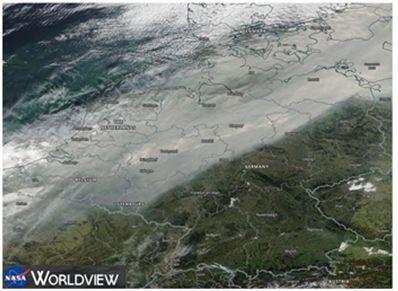A joint research project of KIT, the German Weather Service, and meteocontrol investigates how tiny suspended particles in the air change the weather and the solar irradiance

Credit: https://worldview.earthdata.nasa.gov; direct link at the end of this text
High up in the atmosphere, even the smallest particles lead to the formation of clouds. Air flows that carry Sahara dust to Europe also affect our weather. In the PermaStrom research project, a joint research team from Karlsruhe Institute of Technology (KIT), German Weather Service (DWD), and meteocontrol, a solar energy service provider, is investigating how to better account for such events in weather forecasts. The insights gained from the project should help make more precise yield forecasts for photovoltaic systems. The German Federal Ministry for Economic Affairs and Energy funds this project with 2.5 million euros.
Highly accurate weather forecasts not only help us plan our weekend trip, but are also crucial for power grid management. This is due to the fact that yield forecasts of photovoltaic systems are based on the predictions of solar irradiance. Extensive forest fires or the episodic transport of Sahara dust to Europe can, however, lead to clearly false predictions of solar irradiance on individual days. Transported by ash, dust, and grains of sand, tiny particles enter the atmosphere, contributing to cloud formation. If the photovoltaic yield predictions are incorrect, the missing energy must be provided temporarily by other means.
Scientists of KIT and DWD, jointly with solar energy service provider meteocontrol GmbH, investigate the effects of atmospheric aerosol particles on clouds and solar irradiance in a project called PermaStrom, that covers research on photovoltaic yield predictions for a better management of the influence of atmospheric aeorosols on German and European power grids. The main goal of the project is to better account for these effects in weather forecasts and the photovoltaic yield forecast based on it. So far this has not been possible at all or only poorly.
“For the studies we use both measurement data from weather stations and data provided by satellites,” says Bernhard Vogel, head of the “Aerosols, Trace Gases and Climate Processes” group at the KIT Institute of Meteorology and Climate Research – Department Troposphere Research. This data is then processed in an advanced numerical weather forecasting system that DWD operates especially for this application.
In the predecessor project, PerduS, the researchers already investigated the transport of Sahara dust to Germany and were finally able to improve the predictions in this respect. However, according to the experts, this is not enough. They find it necessary to consider other types of aerosols, such as soot and dust originating from forest fires, and to model and predict the effects of these aerosol particles on cloud formation. “Especially the latter is still a challenge because we have not yet fully understood the processes happening in clouds and their interaction with aerosol particles,” says Axel Seifert from DWD.
By combining the data from observations and improved modeling based on physics with the ICON-ART modeling system, the scientists hope to make progress in understanding these relationships and to achieve a tangible improvement in daily weather forecasts. In this way, they might also find out whether clouds during a Sahara dust event are really different and if so, whether this difference is due to the aerosol particles themselves.
Bridging the gap between research and the application of the findings for power grids
Within the framework of the PermaStrom project, meteocontrol GmbH is developing the forecasting system, taking the requirements of grid operators into account. “Thus, the power grid operators can implement the results of our research in the form of new forecasting models,” states a representative of meteocontrol GmbH. The solar energy service provider develops and provides professional monitoring and control systems for PV systems and portfolios. In addition, the company makes solar energy predictions and creates energy and weather data analyses.
In order to ensure that the users of the new forecasts, which are especially optimized for energy meteorology, are involved in the development at an early stage, the project is being accompanied and supported by the associated partners, Amprion, 50Hertz, and EnBW.
###
More information on the KIT Climate and Environment Center: http://www.
For further information, please contact: Carola Mensch, Editor/Press Officer, Phone: +49 721 608-21170, Email: [email protected]
Being “the Research University in the Helmholtz Association,” KIT creates and imparts knowledge for the society and the environment. It is the objective to make significant contributions to the global challenges in the fields of energy, mobility, and information. For this, about 9,300 employees cooperate in a broad range of disciplines in natural sciences, engineering sciences, economics, and the humanities and social sciences. KIT prepares its 24,400 students for responsible tasks in society, industry, and science by offering research-based study programs. Innovation efforts at KIT build a bridge between important scientific findings and their application for the benefit of society, economic prosperity, and the preservation of our natural basis of life. KIT is one of the German universities of excellence.
This press release is available on the internet at http://www.
The satellite image is available at: https:/
Media Contact
Monika Landgraf
[email protected]




